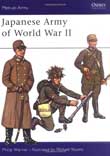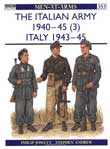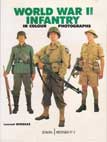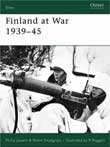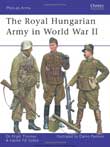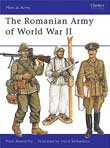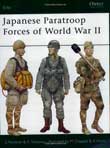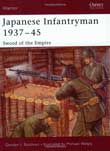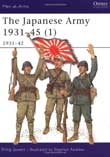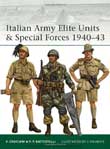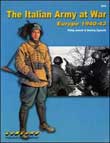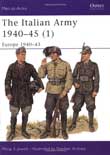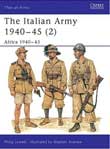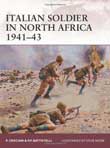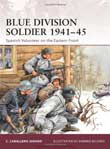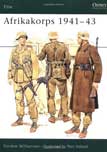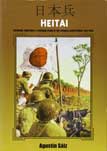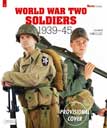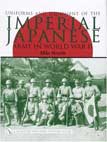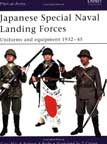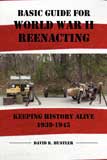

In 1941 the Allied forces in the Pacific were devastatingly unprepared for the onslaught of the Japanese Army, which by this time had been fighting for ten years on the Manchurian front. The Allies paid dearly for their lack of planning and found themselves defeated time and time again as the seasoned Japanese forces swept through the Pacific colonies. This book examines the Japanese concept of war and describes the organization, tactics and weaponry of the Japanese Army from their triumphant invasions of 1941-42 until their ultimate defeat in 1945. Numerous illustrations and colour plates depict the weapons and uniforms of the Japanese troops of World War II in vivid detail.
Immediately after the Allied invasion of Italy in September 1943, Mussolini was deposed and the new Italian government switched sides. The German occupying forces swiftly freed Il Duce and ruthlessly disarmed the Italian Army; and from then until the end of the war in April 1945 Italian troops fought on both sides--with the forces of the new Fascist 'Salo Republic', in the Allied 'Co-Belligerent Forces', and in the Partisan movement. This period of bitter struggle saw the appearance of many new units and a wide range of interesting uniforms, described and illustrated in this final part of Philip Jowett's comprehensive three-volume series.
The 1930s were a time of growing tension for the smaller states of Eastern Europe. Since the end of the First World War they had enjoyed an independence which most of them had not known for centuries, but this was now threatened by the growing power of Nazi Germany and Soviet Russia. Instead of combining for self defence, they were bitterly divided. The Munich crisis of 1938, which served as the prelude to World War II, showed how little reliance could be placed on the Western democracies, whose power to intervene militarily in Eastern Europe was negligible. In effect this left the smaller East European states with little alternative but to become clients of either Germany or Russia.
The Baltic nations - Estonia, Latvia and Lithuania - enjoyed a brief independence between the World Wars before being annexed by the USSR in 1940 during World War II. The grim experience of Soviet occupation made it inevitable that after the German invasion of Russia in 1941 they would fight beside the Wehrmacht as allies against the Red Army while always hoping for restored independence. That hope was crushed again in 1944-45; yet 'Forest Brother' guerrillas continued to fight against hopeless odds for years after the second Soviet occupation. This extraordinary story is illustrated here with rare photos, insignia charts, tables of units and detailed uniform plates.
When speaking of the units of foreign volunteers integrated into the German forces during World War II, the Waffen-SS automatically comes to mind. But, in absolute numbers, more foreigners served with the Wehrmacht in the army, navy and air force. Anti-Communism was the most significant reason why so many volunteers were induced to wear the German uniform. This title examines the Wehrmacht’s foreign volunteers, taking a close look at their uniforms, organisation and distinctive insignia. Among those covered are the Legion Wallanie, LVF, Ostlegionen, Balkan volunteers, Hiwis, Kalmucks, Cossacks, Baltic, Russian and Ukranian volunteers.
It is often forgotten that the German Wehrmacht of 1939-45 relied heavily upon horses. Not only was the majority of Army transport and much of the artillery dependent on draught horse teams; the Germans also kept a horse-mounted cavalry division in the field until the end of 1941. After withdrawing it, they discovered a need to revive and greatly expand their cavalry units in 1943-45. The Army and Waffen-SS cavalry proved their worth on the Russian Front, supported by other Axis cavalry contingents - Romanian, Hungarian, Italian, and locally recruited. In this book an experienced horseman describes that last generation of horse-soldiers in a text supported by tables, photographs, and meticulous colour plates.
Examines the uniforms, insignia, personal equipment and weapons of the fighting men of all major armies of World War II. Rare, original uniforms and equipment are modelled and photographed from a variety of angles. Each example is accompanied by text identifying the items illustrated.
Cutting edge when it was new--still worth having!
Osprey's examination of Finland's involvement in World War II (1939-1945). Finland's fight to defend her independence earned this tiny nation of just 3 million people a distinct place in history. Invaded by Stalin before World War II, Finland held out for months and inflicted huge losses on the invaders, but she was eventually crushed by the weight of Soviet numbers. When Germany invaded the USSR in 1941 the Finns fought alongside the Wehrmacht on the northern Russian Front, with great skill and courage in an attempt to regain their lost territories. When the German armies were forced to retreat in 1944, Finland managed to conclude a separate peace with the USSR – uniquely, without being forced to accept renewed Russian occupation. This book details the organisation, uniforms and equipment of this remarkable force.
The Royal Hungarian Army was Germany's largest ally on the Eastern Front during World War II (1939-1945), providing a vital contribution in terms of both men and equipment. Information about the Hungarian Army in English is rare, and in this book co-authors Nigel Thomas and Hungarian expert Laszlo Szabo fill in the gaps about an important German ally.
Deployed in Ukraine at the beginning of the war, the Hungarian Army were involved in a number of brutal encounters with the Red Army, including stubborn resistance in Transylvania in the summer of 1944 and the brave defence of Budapest in the face of overwhelming odds. The Hungarian Army was a varied and colorful force, ranging from mountain troops and tank units to horse cavalry and specialist infantry. All of these are illustrated in full color artwork, and the text is full of details about the Hungarian Army's own, quite distinct uniforms and insignia as well as many of its own weapons and tanks. With so little of this information readily available outside of Hungary, this is an essential starter resource for war gamers, modelers, re-enactors and military historians.
Although Romania had fought for the Allies in World War I with the fall of her allies the Czechs and the French mid-1940 she was forced to join the Axis. A coalition government was formed under General Antonescue who proved to be one of Germany’s most effective military allies. The Romanian army saw extensive action and suffered terrible losses in operation Odessa and at Stalingrad. By 1944 the Soviets were within the Romanian borders and the King sued for peace. Romania’s defection significantly accelerated the end of World War II. Her natural resources were now denied to Germany and her forces constituted the fourth largest Allied army. this book details the uniforms, equipment and unit organisation of the Romanian army during the entire conflict.
Osprey's examination of Japan's parachute units of World War II (1939-1945). For the first time in English, this book offers a concise but fact-packed account of the organization, equipment, and all operations of Japan's small but elite wartime parachute forces. Correcting and amplifying previous accounts based on wartime intelligence, it traces the Imperial Army's Raiding Regiments and the Imperial Navy's parachute-trained Yokosuka 1st & 3rd Special Naval Landing Forces from the first trials units, through their successful assaults in early 1942, to the last desperate battles and raids of 1944–45. The text is illustrated with rare photographs, and meticulously reconstructed color artwork of the men and their gear.
This book examines in detail the Japanese Infantryman who was, despite comparisons with the notorious German Waffen SS of World War II (1939-1945), an enigma to Westerners. Brutal in its treatment of prisoners as well as the inhabitants of the areas that it conquered, the Imperial Japanese Army also had exacting standards for its own men - strict codes of honor compelled Japanese soldiers to fight to the death against the more technologically advanced Allies. Identifying the ways in which the Japanese soldier differed from his Western counterpart, the author explores concepts such as Bushido, Seppuku, Shiki and Hakko Ichi-u in order to understand what motivated Japanese warriors.
Within months of its greatest triumph in 1942, the Japanese Imperial Army began to face the difficulties which would eventually destroy it - overstretched supply lines, and inadequate industrial support. Yet as the Allies grew steadily stronger and more skilful during World War II (1939-1945), the Japanese Army and Naval Landing Forces dug in to defend their conquests with a determination which shocked all who fought them. In this second book the author describes the deployments, organisation, uniforms and equipment of the Army - including the dreaded Kempei-tai military police - the naval infantry, paratroopers, special raiding units, and foreign auxiliaries during the long and savage war in Burma and the Pacific. His text is illustrated with many rare photographs, three insignia charts, and eight highly detailed colour plates.
During Japan's devastating Pacific offensive of the 1941-42 period of World War II, the Allies paid a high price for their failure to take seriously an army which had already been fighting in Manchuria and China for ten years. That army was a unique blend of the ancient and the modern and its up-to-date equipment and resourceful tactics served an almost medieval code of unquestioning obedience and ruthless aggression. This first of two titles covers the organisation, equipment, uniforms and character of Japanese ground forces in the Chinese and early Pacific campaigns, illustrated with insignia charts, many rare photographs, and eight meticulous uniform plates.
This volume by leading Italian historian, Pier Paolo Battistelli, looks at the elite and special forces units of the Italian Army during World War II (1939-1945). This includes a vast array of troop types including paratroopers, assault engineers, sea-landing and swimmer units, long-range recce and ski units, and even hand-picked Fascist 'Mussolini' units. It also delves into the specialist tank and armoured units that were created to emulate the German armoured units. The Italian units discussed here enjoyed mixed success but the volume does draw attention to the incredible hard fighting done by some, particularly in the deserts of North Africa and the frozen wastelands of Russia. Illustrated with rare archival photographs and specially commissioned artwork this is a fascinating insight into a little-studied aspect of Axis forces.
Nice format, excellent photos.The photo's are of the Italian Army in the Balkan's,or in Russia with the C.S.I.R and cover all areas from Transport, Artillery, Tanks, etc. and just about most aspects of the Italian Army's time in the European theater of War from 1940-43.
The photo's are also supported with informative text and there are also illustrations of some of the men's uniforms etc.--all in all this goes to making a very nice refernce on an often overlooked aspect of WWII.
This book is made up of photographs printed on good quality paper coupled with well-written informative captions. These are fresh photos, not seen often elsewhere and thus bring a new view to this subject. The book includes a nice set of color plates which illustrate weapons, uniforms, etc.
This is a worthy addition to the small amount of English language books covering this much-neglected subject: the Italian forces during WWII.
At its peak the Italian Army contributed 2.5 million troops to the Axis war effort of World War II (1939-1945). English-speaking readers tend to think of this army in terms of the North African campaign; but far more Italian troops served in other theatres. They invaded, and later bore the major burden of occupying, the Balkan countries; and Italy sent 250,000 troops to fight on the Russian Front. In this, the first of a three-part study, Philip Jowett covers the European theatre - including Russia - from 1940 to Italy's armistice with the Allies in 1943. Many interesting uniforms, a number of them new to most readers, are meticulously illustrated by Stephen Andrew.
At its peak the Italian Army contributed 2.5 million troops to the Axis war effort during World War II (1939-1945). In addition to its major role in North Africa, Italy's army invaded, and later bore the main burden of occupying, the Balkan countries. Italy also sent 250,000 men to fight on the Russian Front. In this second book of a three-part study Philip Jowett covers the organisation, uniforms and insignia of the Italian troops committed to both the North African campaign, and the often neglected East African fighting of 1940-41, including the colourful colonial units. Stephen Andrew's meticulous colour plates illustrate a wide range of uniforms.
Focusing on the Italian Army in North Africa during World War II, which fought alongside the Afrikakorps under Rommel versus Montgomery and Patton, this title combines with the previous Warrior series books on the subject (and other Osprey titles) to complete the picture of the War in the Desert.
Despite the attention paid to the Afrikakorps over the years, it was the numerically far superior forces of the Italian Army that held the line and formed the bulk of the fighting power available to the Axis powers during the War in the Desert from 1941 through to 1943. Their performance has been unfairly criticized over the years--the best units of the Italian Army were equal to those of the British and Germans--but they suffered from a lack of mobility and poor equipment that made it impossible for them to meet mobile British forces on anywhere near equal terms. Despite this, the Italian Army went through many changes through the period, with the introduction of a variety of elite units--armoured, mechanised and parachute divisions that did much to restore the fighting reputation of the Italian soldier in the Desert War. Their German allies belatedly acknowledged this with the redesignation of Panzerarmee Afrika as 1st Italian Army in February 1943.
This title details recruitment, organisation and experience of the Italian forces in this theatre, casting new light on a force whose fighting power and capabilities have been unfairly ignored and maligned for too long.
Osprey's survey of the Blue Division soldiers of World War II (1939-1945). The all-volunteer 'Blue Division' was a formation that allowed Franco's technically neutral Spain to support Nazi Germany's invasion of Russia. Following initial training in Germany, the Blue Division's units were sent to the Eastern Front in August 1941, where, after a 40-day march to the front, the Division fought in several major battles including Leningrad. In 1943, with the tide turning against the Axis forces in Russia, the Division was ordered to be withdrawn, yet many men chose to stay on and serve with the Volunteer Legion. Even after the collapse in the East, some volunteered to serve with Waffen-SS units through to the fall of Berlin in 1945. This book narrates the experiences of the common soldier, exploring his motivation for serving the Wehrmacht, and detailing his dramatic experiences in a brutal and hostile theater of World War II.
The Spanish Civil War had been a conflict between the nationalists and conservatives on one side, and what they saw as the opposing anarchic atheistic Marxism which was eroding the traditional Catholic values of Spain. The nationalists eventually won with the aid of Germany against the Soviet backed Marxists, and four years later, the Spaniards seized the opportunity to settle a score with those who had attempted to disintegrate their country. John Scurr's book provides an absorbing account of the organisation, campaigns and uniforms of Germany's Spanish volunteers who fought from 1941-45.
Osprey's study of the German Afrikakorps of World War II (1939-1945). The campaign in North Africa between September 1940 and May 1943 holds not only an enduring fascination for postwar generations; but also a perhaps unique degree of nostalgia for some surviving participants. The campaign was no less costly in terms of human lives and material than many others; but regret at the cost is accompanied by positive memories in the minds of many veterans. This is not to suggest that the dead have been forgotten; but an almost mystical bond nevertheless exists, even between former enemies, amongst veterans of the desert campaign. Gordon Williamson examines the history, organisation and uniforms of Rommel's Afrikakorps.
Once the seemingly invincible conquerors of nearly all of East Asia, today relatively little is known of the exact weapons, uniforms, and lifestyle of World War II Japanese soldiers (the Heitai). In this lavishly illustrated book, readers and historians alike can finally glimpse the precise personal effects of the Imperial infantryman.Thanks to a collection carefully nurtured through the decades, every aspect of the Heitai's daily existence is shown in detail with superb color photography accompanied by informative descriptions. Items range from weapons to clothing (both tropical and arctic), eating implements, communications equipment, awards, helmets, insignia, visual devices, gas masks, canteens, cameras, tents and footwear. Also included are propaganda leaflets and simple reading material issued to the Heitai during long, slow periods of service on isolated (sometimes bypassed) Pacific islands.By examining the exact possessions of a Japanese soldier-from dagger to toothbrush, from hand grenade to undergarments-one is able to see history come to life in a way no cinema or text alone could convey. At the same time, it is of interest to note both the differences between an Imperial fighter's equipment with that of a GI, and how in many ways it was similar.As a companion volume to the bestselling Deutsche Soldaten, this over-sized, one-of-a-kind work on the Imperial Heitai provides a uniquely illuminating view of the Japanese fighting man who was once America's most fearsome enemy.
Presented here in this eighth Militaria guide are detailed color illustrations of the uniforms and equipment of combat infantrymen of WWII, displayed on live models.
Only authentic pieces from several private and public collections have been chosen for this work, and are presented on the man as they were carried on the battlefield.
Each of these 31 soldiers, Polish, Belgian, French, German, British, Italian, Russian and North American, is photographed from the front and back to reveal every detail and accompanied by detailed captions.
Among the major powers of World War II, the uniforms and equipment of the Japanese army have received the least coverage. This new, detailed volume presents the subject with a superb collection of actual vintage items, and rarely seen World War II era photographs. Among the subjects covered are: the Imperial Japanese army uniform series; undergarments; footwear; headwear; personal field equipment; extreme climate uniforms; work and specialty uniforms; soldier's personal items; and firearms. A short chapter examines reproductions.
The spearhead of Japan's assault landing operations both in China pre-Pearl Harbor, and in US and British territory post-Pearl Harbor, was provided by the Special Naval Landing Forces - 12 numbered battalion-size Imperial Japanese Navy units. They garrisoned a number of the islands which the US Marines then had to re-claim in some of the bloodiest battles of the Pacific War of World War II (1939-1945). These included the infamous battles of Iwo Jima and Okinawa. This book provides a comprehensive treatment of the elite force which has never before been examined in such detail in English, covering weapons and equipment as well as uniform and insignia.
Have you ever been obsessed in war history, particularly about World War II? You have seen reenactments of that significant moment in our time that you are thinking of participating in such an endeavor. However, you don't know how to start.
Fret no more. David Hustler, a veteran of many reenactments of historical battle events, is giving you the head start by imparting tips of the ins and outs of perfecting your own impression of a soldier of the Second World War. He will guide you from buying the proper uniforms and equipments to joining your own group or units, and from the right way of caring for your costume and implements to maintaining a good attitude in the field. Avoid being called a farb on your first day as a reenactor. Follow the expert.
John IV begins his reign as Catholic Pope
Pope Clement II, [Suitger] elected
Cardinal Benedetto Gaetani chosen as Pope Boniface VIII
400 Burgundy soldiers freeze to death during siege of Nancy
Thomas Wolsey appointed English Lord Chancellor
Compromise of the Nobles closes against inquisition
Storm hits Texel: 40 ships hit, 500 killed
John van Riebeeck departs to Cape of Good Hope
Swedish troops occupy Norway
Benjamin Franklin arrives in London
Russia and England sign Second anti-French Coalition
Jakobijns plot against Napoleon uncovered
"Silent Night" composed by Franz Joseph Gruber; 1st sung next day
Franz Xaver Gruber composes "Silent Night"
1st US Negro hospital founded by whites chartered - Savannah, Georgia
HMS Beagle anchors in Wigwam Bay at Cape Receiver
Fire devastates Library of Congress in Washington, destroys 35,000 volumes
US Library of Congress catches fire; 35,000 books burn
Battle of Gordonsville, Virginia
Several Confederate veterans form Ku Klux Klan in Pulaski, Tennessee
Pope Pius IX proclaims a jubilee for 1875
Daniel Stover and William Hance patent bicycle with back pedal brake
Henry Ford completes his 1st useful gas motor
Scheveningse fishing boats destroyed by storm
German SW Africa abolishes slavery of young children
Reginald A Fessenden became 1st to broadcast music over radio (Mass)
Irving Fisher patents archiving system with index cards
German plane drops bombs on Dover England
Enrico Caruso gives his last public performance (NYC)
BBC sends 1st British radio play "Truth about Father Christmas"
London Coloseum opens
1st radio transmission of NCRV in the Netherlands
George Abbott Theater (Adelphi, 54 St) opens at 152 W 54th St, New York City
Bandung, Java: ir Sukarno 4 years jail sentenced
Arturo Alessandri wins presidental election in Chile
Paris express train derails and kills 160, injures 300 (France)
Grimmett takes 9-180 for SA as Queensland make 430
Bradman scores 233 in 191 mins, South Africa vs. Queensland, 28 fours 1 six
National Council of Negro Women forms
1st radioactive isotope medicine administered, Berkeley, California
Dutch government recognizes Italian King Emanuel III as Emperor of Abyssinia
Red army occupies German airports at Tasjinskaja and Morozowsk
FDR appoints General Eisenhower Supreme Commander of Allied forces
4th French Republic established
1st US house completely sunheated is occupied (Dover, Massachusetts)
Greek government disbands due to state of war, press censorship
Cleveland Browns win NFL championship, beat LA 30-28
1st televised opera (Amahl & Night Visitor)
United Kingdom of Libya gains independence from Italy via UN
2 fast express trains crash head-on killing 103 (Czechoslovakia)
KHOL (now KHGI) TV channel 13 in Kearney, NB (ABC) begins broadcasting
KOA (now KCNC) TV channel 4 in Denver, CO (NBC) begins broadcasting
Wellington-Auckland (New Zealand) express train swept away in flood kills 166
Council for the Children Protection forms in Neth
Laos gains its independence
"I Love Lucy" Christmas show airs, never put in syndication
Ferdinand de Lesseps statue blown up in Port Said Egypt
Dutch bishops question papacy values
Houston Oilers beat San Diego Chargers 10-3 in AFL championship game
Greek and Turks riot in Cyprus
Shooting begins on "The Cage" the pilot for Star Trek
"Joyful Noise" closes at Mark Hellinger Theater NYC after 12 performances
Luna 13 lands on Moon
USAF C144 military charter crashes near Binh Thai Vietnam kills 129
Pirate Radio Pegasus starts broadcasting off New Zealand
Apollo 8 Astronauts read passages from Book of Genesis
WATU (now WAGT) TV channel 26 in Augusta, Georgia (CBS) begins broadcasting
9 Jews are convicted in Leningrad of hijacking a plane
Peruvian Airlines Electra crashes at headwaters of Amazon, killing all except Juliane Margaret Koepcke found 10 days later
Ferryboat capsized off coast of Equador, drowning 200
1st Ariane-rocket launched
Americans remembered Iran hostages by shining lights for 417 seconds
Guardian Angels Curtis Sliwa and Lisa Evers marry
Chaminade, with a student body of only 850 students, beats #1 ranked Virginia 77-72 in a Honolulu holiday basketball classic
Palace coup in Mauritania
French hostage Aurel Cornea, held in Lebanon for 9 months, released
Iran offensive against Iraqi islands of Shatt al-Arab
Charles Taylor enters Liberia to unseat President Samuel K Doe
Expos trade Tim Raines to White Sox for Ivan Calderon and Barry Jones
Mikhail Gorbachev resigns as head of Soviet Union
President Bush pardons Caspar Weinberger of Iran-contra affair
4 Moslem fundamentalists capture Air France pilot in Algiers
1st time a Chanukah candle is officially lit in Vatican City
